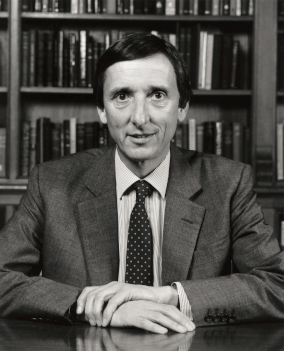John Newsom-Davis facts for kids
Quick facts for kids
John Newsom-Davis
|
|
|---|---|
 |
|
| Born | 18 October 1932 Harpenden, Hertfordshire, England, United Kingdom
|
| Died | 24 August 2007 (aged 74) Adjud, Romania
|
| Nationality | British |
| Citizenship | British |
| Alma mater | Pembroke College, Cambridge |
| Awards | |
| Scientific career | |
| Fields | Neurology |
| Institutions |
|
| Influences | Michael Kramer |
| Influenced | Angela Vincent |
John Michael Newsom-Davis (18 October 1932 – 24 August 2007) was a famous neurologist. A neurologist is a doctor who studies the brain, spinal cord, and nerves. He made very important discoveries about diseases that affect how our nerves and muscles work together.
These diseases include Myasthenia gravis, Lambert–Eaton myasthenic syndrome, and acquired neuromyotonia. He was known as one of the best doctors and scientists of his time. Sadly, he died in a car accident in Adjud, Romania, after visiting a clinic.
Contents
Early Life and Education
John Newsom-Davis was born in Harpenden, Hertfordshire, England. He was the oldest child and only son of Kenneth and Eileen Newsom-Davis. He also had a twin sister named Julia.
He went to Sherborne and then to Pembroke College at the Cambridge University. From 1951 to 1953, he served in the RAF. During this time, he learned to fly Meteor jet fighters.
In 1963, he married Rosemary Elizabeth Schmid. She later became a psychologist who helped children develop. They had two daughters and one son, and seven grandchildren.
His Medical Career
John Newsom-Davis became a doctor in 1960. He first worked at the National Hospital, Queen Square. There, he studied how breathing works in the body.
He then spent a year in New York City, learning more about breathing. When he came back in 1970, he became a consultant neurologist. He worked at both the National Hospital and the Royal Free Hospital.
At the Royal Free Hospital, he built a strong research team. In 1980, he became the first MRC Clinical Research Professor. This was a very important position.
In 1987, he moved to Oxford University. He became the Action Research Chair of Clinical Neurology. He brought most of his research team with him. At Oxford, he helped grow the study of brain and nerve diseases. He also started a world-leading center for brain imaging.
From 1997 to 2004, he was the editor of a major neurology journal called Brain. He helped make it one of the first science journals available online.
Awards and Recognition
John Newsom-Davis received many important awards for his work. In 1973, he became a Fellow of the Royal College of Physicians. This is a high honor for doctors.
In 1991, he was elected a Fellow of the Royal Society. This is one of the oldest and most respected science academies in the world. He was also given a CBE award in 1996.
In 1997, he received the Ellison-Cliffe Medal. His work was also recognized by groups in the United States. He became an honorary member of the American Academy of Neurology. He was also elected as a foreign member of the Institute of Medicine.
Later Years and Continued Work
Even after he "retired" from Oxford in 1998, John Newsom-Davis kept working. He continued to edit the Brain journal until 2004. He also held a weekly clinic for patients with Myasthenia gravis.
He traveled a lot to give lectures around the world. He also took on a huge project with the National Institutes of Health in the United States. He helped organize a large study involving over 80 centers. This study aimed to find out if a surgery called thymectomy is a good treatment for myasthenia gravis.
Images for kids


